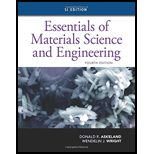
Interpretation:
The element which will provide the higher strength to the alloy is to be determined. Also, the element which will have unlimited solubility in copper is to be determined.
Concept Introduction:
A property of a substance known as solute whether it is solid, liquid, or gaseous to get dissolved in the solid, liquid or gaseous solvent is known as solubility.
When two or more solid chemical substances are dissolved in each other and only one phase appears after mixing irrespective of any concentration of the solute in the solvent, then there is unlimited solid solubility.
In alloying, the strength of the alloy is dependent on the difference in the size of its constituent elements. More is the difference in the size, higher is the strength of the alloy.
Hume-Rothery rules are the conditions which are to be satisfied to attain unlimited solid solubility. These rules are stated as:
1. The size of the atoms or the ions involved should be similar to minimize the lattice strain. This means that there should not be more than
2. The crystal structure of both the materials should be same to avoid different structure caused due to the transition from one phase to another phase at some point.
3. The difference in the valency of the ions causes the formation of compounds rather than solutions. Thus, the valence of the ions must be same.
4. The significant difference in the electronegativity (affinity for electrons) caused the compound formation rather than solutions. Therefore, the electronegativity of atoms must be approximately same.
Trending nowThis is a popular solution!

Chapter 10 Solutions
Essentials Of Materials Science And Engineering, Si Edition
- Can you show how this answer was found:arrow_forwardDraw shear and moment diagrams for the attached image.arrow_forwardQ1 [2 point] Perform 13+10 in the following Adder- Subtractor: A= |B= A3 B3 IB2 B1 A0 BO FAH FAH FAH FA M CO Q2 [2 point] Perform 13-10 in the following Adder- Subtractor: A= B= A3 B3 A2 B2 A1 B1 A0 BO A = = BC= AB FA FA FA FA M COarrow_forward
- Consider a Superstore Database which consists of 3 tables, Orders, Returns, and Managers. The CSV files have been provided along with this DOC file in the Midterm 2 Link in the Moodle. Answer the questions as below: Use the created table as in the provided SQL query file, solve the problems as mentioned below. You will have to import the respective CSV files of the above created tables as without them, it is impossible to solve the questions below. If you are not able to upload the files successfully, do not leave the query questions. Just write the query to the best of your knowledge. Do not copy. To be graded for the screenshot answer, you must upload the CSV properly and paste the resulting screenshot of the queries as asked. Write Query to Find out which Product Sub-Category has a sum of Shipping Cost to sum of Sales ratio > 0.03.arrow_forwardI need help solving this problemarrow_forwardMatlab Homework (20ps) A BFSK signal is transmitted through a channel with AWGN. Generate similar BFSK received signal plots as shown on next page. (20 pts) BFSK for eb-1 and npower=0.01 with 500 samples BFSK for eb=1 and npower=0.1 with 500 samples 2.5 2.5 2 1.5 1 0.5 0 -0.5 -1 2 1.5 1 0.5 0 0.5 -1 -1.5 1.5 -1.5 -1 -0.5 0 0.5 1 1.5 2 2.5 -1.5 -1 -0.5 0 0.5 1 1.5 2 2.5arrow_forward
- Can you show how this answer was found?arrow_forward1. You are to design a 9-volt battery operated baseband PAM communication system that must last great than 10 years without replacing the batteries. The application requires a BER of <10^-4 and a data rate of 200bps. The channel can be modeled as AWGN with a noise power spectral density of 10^-9 W/Hz and a channel loss of 10 dB. (a) Estimate the required capacity of the batteries. (The battery life (hours) is equal to the battery volts times of the battery capacity (Amps* hours) divided by the total load (Watts)) and (b) Can you easily find this battery? If not, what would you suggest be done?arrow_forward3. You are on a design team tasked to design a system of remote sensors that use PAM. Here is what the team knows/assumptions: The remote sensor will use a single AA battery required to power the sensors. The system has a bandwidth of 2KHz and requires a data rate of 12 Kbps and a BER of less than 1*10^-4. The typical channel has maximum losses of 35 dB and a noise power spectral density is 10^-9 W/Hz. Your boss assigns you with the task of estimating how long the battery will last.arrow_forward
- Can you solve for me pleas the question determine all member forces using joint methodarrow_forwardA very thin metallic sheet is placed between two wood plates of different thicknesses. Theplates are firmly pressed together and electricity is passed through the sheet. The exposed surfaces ofthe two plates lose heat to the ambient fluid by convection. Assume uniform heating at the interface.Neglect end effects and assume steady state.[a] Will the heat transfer through the two plates be the same? Explain.[b] Will the exposed surfaces be at the same temperature? Explainarrow_forwardI need help solving this question, I don't know how to approach itarrow_forward
 MATLAB: An Introduction with ApplicationsEngineeringISBN:9781119256830Author:Amos GilatPublisher:John Wiley & Sons Inc
MATLAB: An Introduction with ApplicationsEngineeringISBN:9781119256830Author:Amos GilatPublisher:John Wiley & Sons Inc Essentials Of Materials Science And EngineeringEngineeringISBN:9781337385497Author:WRIGHT, Wendelin J.Publisher:Cengage,
Essentials Of Materials Science And EngineeringEngineeringISBN:9781337385497Author:WRIGHT, Wendelin J.Publisher:Cengage, Industrial Motor ControlEngineeringISBN:9781133691808Author:Stephen HermanPublisher:Cengage Learning
Industrial Motor ControlEngineeringISBN:9781133691808Author:Stephen HermanPublisher:Cengage Learning Basics Of Engineering EconomyEngineeringISBN:9780073376356Author:Leland Blank, Anthony TarquinPublisher:MCGRAW-HILL HIGHER EDUCATION
Basics Of Engineering EconomyEngineeringISBN:9780073376356Author:Leland Blank, Anthony TarquinPublisher:MCGRAW-HILL HIGHER EDUCATION Structural Steel Design (6th Edition)EngineeringISBN:9780134589657Author:Jack C. McCormac, Stephen F. CsernakPublisher:PEARSON
Structural Steel Design (6th Edition)EngineeringISBN:9780134589657Author:Jack C. McCormac, Stephen F. CsernakPublisher:PEARSON Fundamentals of Materials Science and Engineering...EngineeringISBN:9781119175483Author:William D. Callister Jr., David G. RethwischPublisher:WILEY
Fundamentals of Materials Science and Engineering...EngineeringISBN:9781119175483Author:William D. Callister Jr., David G. RethwischPublisher:WILEY





